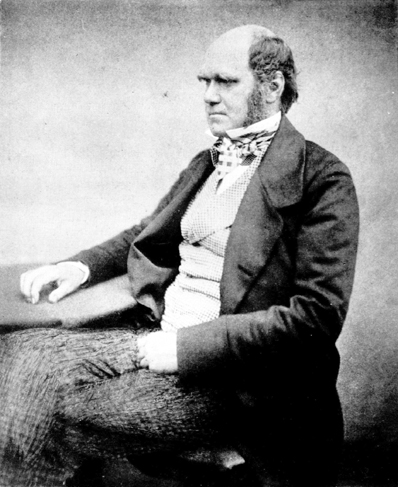 A.
Overview:
A.
Overview:
One of the great ironies of science is that the two greatest contributions in biology - the theory of evolution and the mechanistic principles of heredity - were described independently of one another within a ten year period. It is ironic because genetics (heredity) and evolution are so critically and intimately related...heredity describes how genetic information is passed from parent to offspring. This creates relatedness patterns within families, within species among populations, and among species. These relationships are a focus of evolutionary studies. The publications marking their official, orthodox ‘births’ were published only six years apart: Origin of Species (1859), and Experiments in Plant Hybridization (1865), yet it was nearly 80 years before these ideas were placed in their proper context within the Modern Synthetic Theory of evolution. In the first part of this course, we will examine these contributions in a historical context. We will also briefly describe the cellular context in which the genetic system operates.
 A.
Overview:
A.
Overview: a. He summarized
the evidence for evolution (common descent) as an historical fact
b. He proposed mechanistic theories explaining ‘how’ evolution
might occur (Natural Selection, use and disuse)
c. He addressed the major problems with his ideas; notably
the ideas of apparent design (Paley), the discontinuity of the fossil record
(Cuvier), and the source of observed variation.
1. Geology
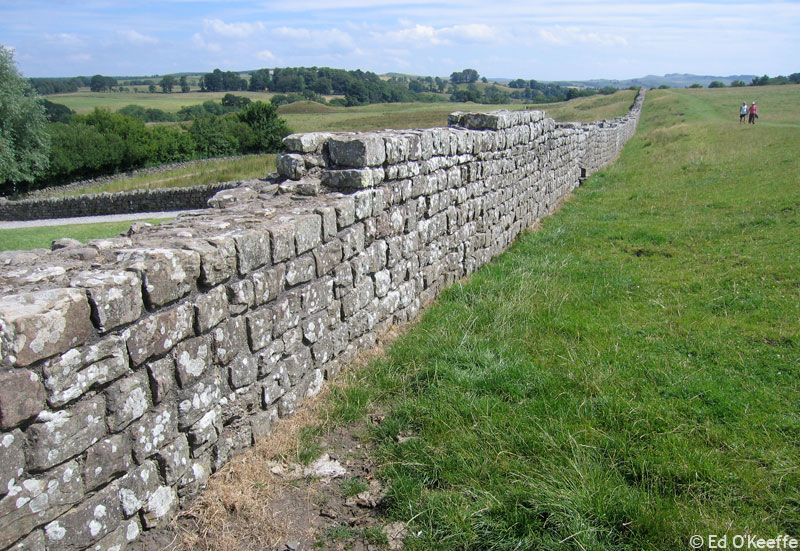 a.
James
Hutton (1726-1797): Hutton was the first great british geologist.
He compared Hadrian's wall - which looks new but was 1600 years old (122 AD)
- with natural rock outcrops that were strongly weathered. Hutton concluded
that the natural outcrops must be 100's of times older. He also examined an
important formation at Siccar Point, where one series of nearly vertical strata
is overlain by another series of horizontal strata. This is now called an 'unconformity',
and Hutton explained it as follows. Based on Steno's laws of superposition,
the bottom vertical sediments must have been laid down first, and they must
have been laid down horizontally. Ages must have passed between each deposit,
as each turned to rock. Then, uplifts must have occurred to bend them into a
vertical aspect. Long periods of erosion must take place to wear that uplift
flat, followed by the long intervals of time needed to deposit the second horizontal
series. Also, if erosion and deposition acted slowly (as current observations
show), then it must have taken a really long time to erode mountains or build
up marine deposits (White Cliffs of Dover). He concluded that this slow, 'uniformitarian'
cycle of deposition, uplift, erosion, and deposition meant that the Earth was
unfathomably old. Indeed, the cycle may mean that it's age might not be discoverable.
In short, Hutton concludes, the Earth has "no vestige of a beginning, no prospect
of an end."
a.
James
Hutton (1726-1797): Hutton was the first great british geologist.
He compared Hadrian's wall - which looks new but was 1600 years old (122 AD)
- with natural rock outcrops that were strongly weathered. Hutton concluded
that the natural outcrops must be 100's of times older. He also examined an
important formation at Siccar Point, where one series of nearly vertical strata
is overlain by another series of horizontal strata. This is now called an 'unconformity',
and Hutton explained it as follows. Based on Steno's laws of superposition,
the bottom vertical sediments must have been laid down first, and they must
have been laid down horizontally. Ages must have passed between each deposit,
as each turned to rock. Then, uplifts must have occurred to bend them into a
vertical aspect. Long periods of erosion must take place to wear that uplift
flat, followed by the long intervals of time needed to deposit the second horizontal
series. Also, if erosion and deposition acted slowly (as current observations
show), then it must have taken a really long time to erode mountains or build
up marine deposits (White Cliffs of Dover). He concluded that this slow, 'uniformitarian'
cycle of deposition, uplift, erosion, and deposition meant that the Earth was
unfathomably old. Indeed, the cycle may mean that it's age might not be discoverable.
In short, Hutton concludes, the Earth has "no vestige of a beginning, no prospect
of an end."
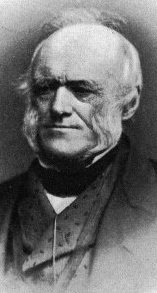 b.
Charles Lyell (1797-1895):
Lyell promoted Hutton's ideas of a great age to the Earth and uniform rates
of change - making inferences based on the assumption of constant rates of physical
processes. Small changes, accumulating over a long time, could have big
effects. Lyell's three volume work Principles of Geology (1830-33)
opened Darwin's eyes as he read them on the H.M.S. Beagle. Geology opened "deep
time".... the Earth was at least 100's of thousands of years old, and natural
processes working slowly, gradually, and cumulatively through time could affect
large changes. Lyell was Darwin's contemporary and personal friend, although
he was distressed by Darwin's evolutionary ideas.
b.
Charles Lyell (1797-1895):
Lyell promoted Hutton's ideas of a great age to the Earth and uniform rates
of change - making inferences based on the assumption of constant rates of physical
processes. Small changes, accumulating over a long time, could have big
effects. Lyell's three volume work Principles of Geology (1830-33)
opened Darwin's eyes as he read them on the H.M.S. Beagle. Geology opened "deep
time".... the Earth was at least 100's of thousands of years old, and natural
processes working slowly, gradually, and cumulatively through time could affect
large changes. Lyell was Darwin's contemporary and personal friend, although
he was distressed by Darwin's evolutionary ideas.
2. Paleontology
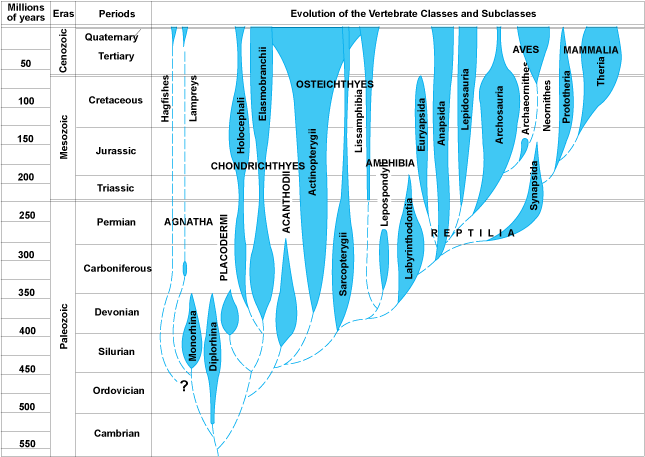 Paleontology
provided a variety of interesting patterns. First, there were extinct forms
that were different from the species alive today. Although some earlier natural
philosophers suggested that the creatures might still exist in some unexplored
corner of the globe, that was a less satisfying hypothesis in the mid-1800's...
most areas of the globe had been visited by Europeans. Also, the idea of extinction
was repugnant to some people on theological grounds. If God had created a perfect
world, then extinction renders that creation imperfect. Also, if species could
go extinct since the creation, could species also come into existence since
the creation? Just how dynamic was this system?
Paleontology
provided a variety of interesting patterns. First, there were extinct forms
that were different from the species alive today. Although some earlier natural
philosophers suggested that the creatures might still exist in some unexplored
corner of the globe, that was a less satisfying hypothesis in the mid-1800's...
most areas of the globe had been visited by Europeans. Also, the idea of extinction
was repugnant to some people on theological grounds. If God had created a perfect
world, then extinction renders that creation imperfect. Also, if species could
go extinct since the creation, could species also come into existence since
the creation? Just how dynamic was this system?
Darwin was impressed by two major patterns in the fossil record.
1. The major groups of animals accumulate in an orderly manner'. Everything is not represented at the beginning. In vertebrates, for instance, the fishes appear first, and exist throughout the rest of the record. Amphibians appear next, followed by reptiles, mammals, and birds. So it is not everything at the beginning, and it is not a replacement. Where did mammals come from? Spontaneous generation had been refuted, so Darwin knew that mammals had to come from other pre-existing animals. But the only completely terrestrial vertebrates before mammals were reptiles.
2. A second major pattern occurred within some lineages of similar organisms. Within some lineages, we seen orderly change in the size or characteristics of species in a geological sequence. For instance, consider the morphological patterns in a particular taxon (horses). Fossils in a stratigraphic sequence are similar, but often have traits that form a continuum...like the progressive loss of digits on the horse limb. And, with each innovation, there are often radiations - a "spurt" in the number of species that show this new trait. And finally, these species in recent strat are more similar to living ('extant') species than the species found in deeper, older strata. So, many of these transitional sequences terminate in living representatives.
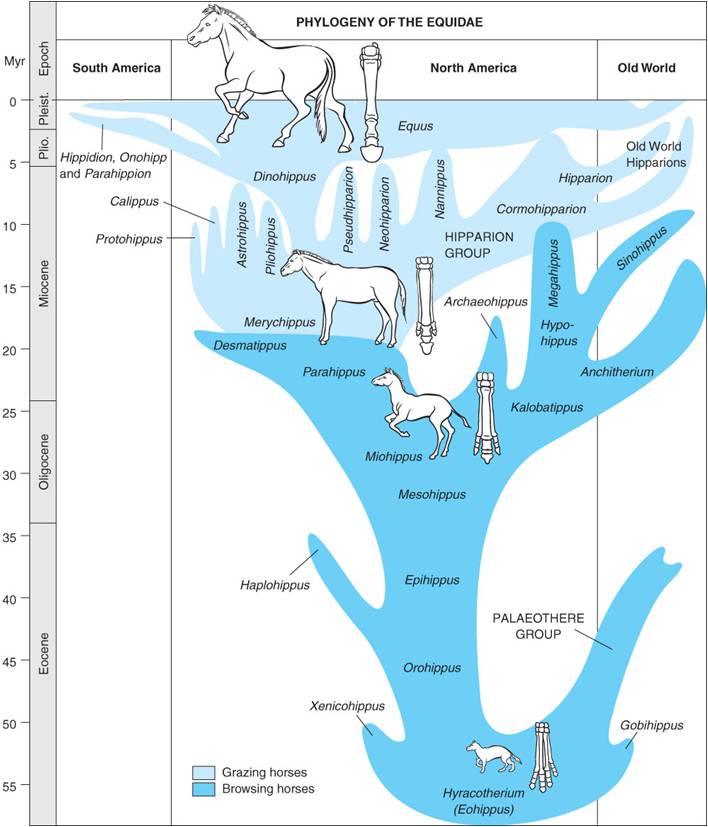
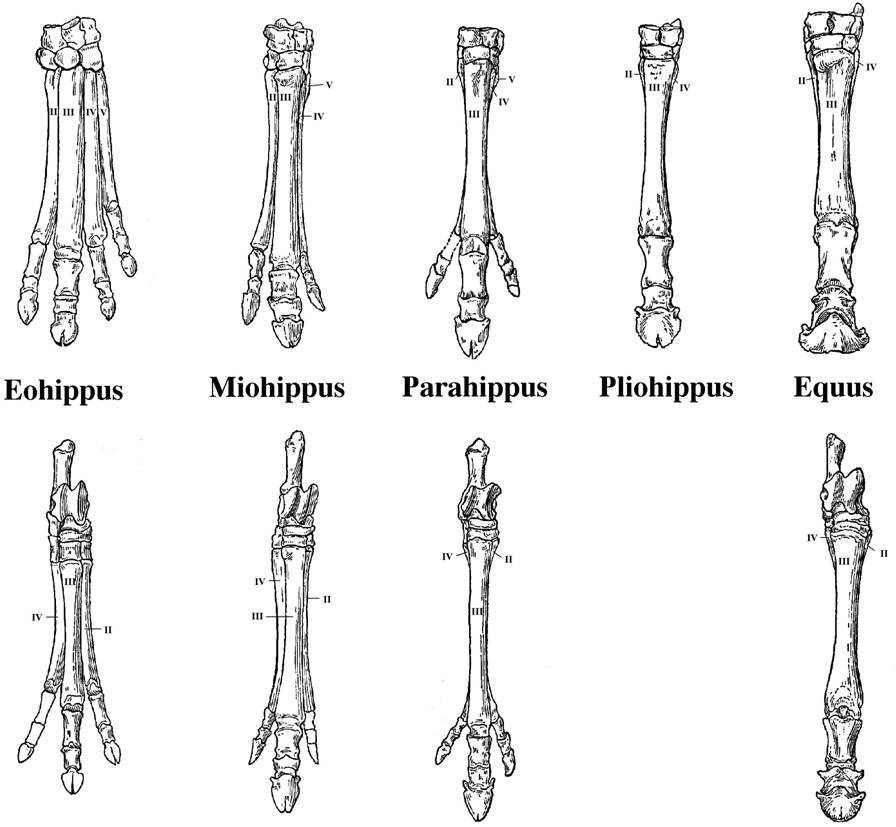
3. Comparative Anatomy
 a.
Homologous Structures
a.
Homologous Structures
Although having a different outward "look" and although used
for different purposes, they have an underlying similarity in structure - forelimbs
of vertebrates all have one long upper arm bone, two lower arm bones, a bunch
of wrist bones, and five digits. Darwin saw the similarity in structure as important.
An engineer builds different things for different purposes - cars, boats, and
airplanes are structurally DIFFERENT. Here, however, it seemed as if one basic
structure was modified for different uses. Darwin knew why siblings in a family
were similar - they had the same parents (ancestors). He reasoned that these
structural similarities in different species might be due to the same principle
- common ancestry. Also, he observed a correlation: Different uses correlated
with different environments. Could this correlation be causal?
b. Analogous
Structures
Organisms in the same environment often have a similar outward
structure or body plan. For example, flying animals all have an aerodynamic
wing that is wider at the front than at the rear. However, the wings of differnt
animals are differnt in underlying structure. Bats have fingers that support
the membraneous wing, whereas birds lack fingers and the body of the wing consists
of feathers. Insect wings don't involve the limbs at all (even though they have
6!). Again, Darwin observed this correlation with the environment: similar use
(and outward structure) in similar environments. Could this correlation be causal?
c.
Vestigial Organs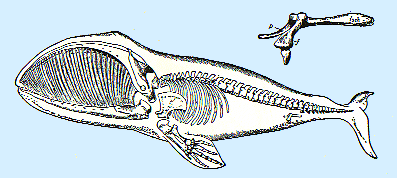
These are organs that have no function in one organism (where
they are 'vestigial') but they do function in other organisms. So, some whales
have hip bones, but no legs. Why do they have these bones? Darwin was struck
by the IMPERFECTIONS in nature, as much as the adaptations. Why do men have
nipples? Why do we have muscles that wiggle our ears? Why do we have strong
muscles in the front of our stomach, which are not "load-bearing", and weak
muscles at the base of our abdomen (which rupture in a hernia)? This is a reasonable
relationship in a quadraped, but not in a biped. Why do we have tail bones,
but no external tail? Again, these are NOT well-designed features. In fact,
attributing these imperfect designs to a perfect creator could be interpreted
as heretical. However, when we see them working in OTHER species, it suggests
that maybe we inherited them from common ancestors where they DID serve a function.
As a scientist, Darwin was trying to explain ALL the data (adaptations and imperfections),
he was not simply bringing forward only the data that supported a preferred
position (design).
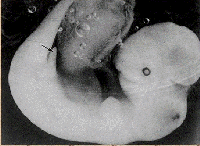 d.
Embryology
d.
Embryology
Embryology reveals homologies and
vestigial structures in both the anatomy of embryos and the process of their
development. For Darwin, the notion that very different vertebrates, such as
fish, amphibians, reptiles, birds, and mammals, would develop from very similar
initial forms was inexplicable from a 'separate creation' perspective. For example,
why do whale embryos (like the one pictured to the right) have hind limb buds?
Why do all vertebrates have folds of tissue in the neck, when only fish develop
them into functional gill slits in the adult? Some anomalies like the recurrent
laryngeal nerves of mammals (described in your book) are explicable in a developmental,
comparative, evolutionary context. Although no modern evolutionary biologist
propounds the notion that an organism "traces their evolutionary history"
as they develop from an egg (this was Haeckel's post-Darwinian idea that "ontogeny
recapitulates phylogeny"), and Haeckel's drawings grossly exaggerated the
similarities among vertebrate embryos, embryos are far more similar to one another
than adults, and embryos are more similar to other embryos than they are to
their own adult form. As we will see when we look at modern contributions from
genetics and developmental biology, the similarities in development are even
more dramatic than anatomy alone suggests.
Study Questions:
1. What where the three things Darwin did in Origin of Species?
2. What is "uniformitarianism" and how was it important to the development of Darwin's ideas?
3. What observations did Hutton make, and what did he conclude from these observations?
4. What two patterns occur in the fossil record that impress Darwin regarding the hypothesis of evolution and common descent?
5. What are homologous structures? What correlations occurs with the environment?
6. What are analogous structures? What correlation occurs with the environment?
7. What are vestigial structures, and why were they so important to Darwin's refutation of Paley?